Jason Momoa Aquaman
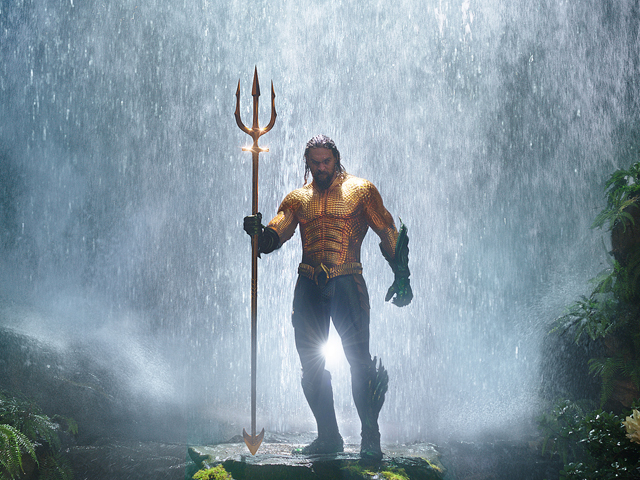
Atlantis Has Always Had A King…Now It Needs Something More
Cast: Jason Momoa, Amber Heard, Willem Dafoe, Patrick Wilson, Dolph Lundgren, Yahya Abdul-Mateen II, Nicole Kidman, Ludi Lin, Temuera Morrison
Director: James Wan
Genre: Action, Adventure, Fantasy
Synopsis: The film reveals the origin story of half-human, half-Atlantean Arthur Curry and takes him on the journey of his lifetime one that will not only force him to face who he really is, but to discover if he is worthy of who he was born to be… a king.
Aquaman
Release Date: December 26th, 2018
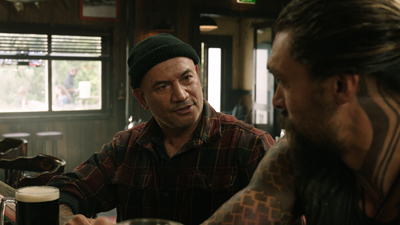 About The Production
About The Production
The Fate Of Two Worlds Lies With One Hero
In "Aquaman," Arthur Curry's quest to unite two worlds begins with a challenge that will test both his strength and the courage of his convictions: to retrieve the Lost Trident of Atlan. Only the true King of Atlantis can wield it, but to even find it he must partner with Mera, Princess of the ocean kingdom of Xebel, on a treacherous journey over land and sea.
The first hurdle Arthur must overcome is his own disinterest in being the solution to anyone's problem"be it the Atlanteans' or mankind's. Up until now, he's been satisfied operating as something of a super powerful lone wolf, choosing his own waterborne battles and avoiding involvement in any sort of global civil war.
Visionary director/co-writer James Wan was excited to undertake the first standalone feature for this complex character. "Aquaman is a very powerful guy and can handle action on a god-like scale. But what I love most about him is that what drives him comes from a very human place," he says. "To me, the most important thing is the story I'm telling and that audiences care about the characters and want to go along on their adventure."
Producer Peter Safran, who has worked extensively with Wan, states, "James knew the story he wanted to tell, the tone of it and the look of it, and he never wavered from that course."
Titular star Jason Momoa underscores his character's relatability by deftly masking Arthur's vulnerabilities and playing up his tough, sarcastic side, bringing his unique brand of humor to this new kind of DC Super Hero. "The script had this beautiful origin story that follows a child as he gets his powers, and ultimately goes on a man's journey to becoming a king. But there was definitely a lighter side to him throughout, even as he goes in and fights for his life in James's incredibly cool underwater galaxy war," Momoa relates.
"Superheroes and villains are the embodiment of the best and worst parts of us," adds Amber Heard, who stars as Mera. "That duality is what resonates with everyone, especially kids, who are receptive in ways that adults may not be." And while, up until now, big screen heroes have primarily been male, the actress was thrilled with the parity she found on the pages of the "Aquaman" screenplay. "They're partners from the beginning, and though their personalities are combative, they develop a fun banter and a mutual respect, and there is no question that it will take both of them, working together, for Arthur to fully realize his destiny."
While Aquaman was introduced to comic book readers in 1941, the story told in the film, written by Wan and executive producer Geoff Johns, was largely inspired by Johns' Aquaman comic from The New 52, a 2011 series in which DC relaunched its Super Hero line. "Geoff has a tremendous breadth of knowledge when it comes to the history of Aquaman, and all the DC Super Heroes," Safran notes. "He was eager to collaborate with James to tell the version of Arthur's story we wanted to tell."
Johns observes, "Arthur grew up on land and never knew about his heritage until years later, when he went to Atlantis and discovered this amazing underwater society, the mysteries of the oceans and creatures of different races, beings that live right here on Earth but are as alien as creatures from outer space. James saw that and realized that Aquaman"who brings with him a great story about someone trying to find his lineage and embrace his heritage"also comes with the environment that he inhabits, which goes for every DC character. Every one of the icons in the DC universe has this expansive canvas that their stories are painted across, and James had an inspired vision of how to translate Aquaman's fantastical world to the big screen."
Screenwriters David Leslie Johnson-McGoldrick and Will Beall scripted the larger-thanlife tale. "First and foremost, James wanted this to be a fun, globetrotting quest movie," states Johnson-McGoldrick. "That said, family is one of the most important aspects of the film. Aquaman inherits his powers from his mother and his humanity from his father, two people who came from different worlds and fell in love despite all odds. He is a product of that love…and of growing up after they were torn apart. Where is he supposed to fit in?"
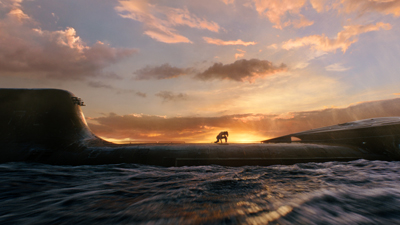 Because Arthur's parents' relationship was forbidden, to him it feels like a personal affront"one that carries with it the sense of alienation he's felt his whole life. What Arthur may not fully realize is that, though his mother, Queen Atlanna, left him after a violent attack on their home forced her to realize the danger she posed to her firstborn, she left him with numerous gifts. Due to the Atlantean side of his DNA, Arthur discovers as a child that he possesses various superhuman abilities: he can breathe underwater, swim at tremendous speeds, withstand great ocean depths making him almost invulnerable, and, yes, "talk to fish," telepathically communicating with marine life. In addition to his underwater prowess, he is also gifted with superhuman traits on land: he has extraordinary strength, enhanced senses and impenetrable skin. With the escalating conflict between land and sea coming to a head, Arthur must call upon all his resources to defend both the Earth's land and its oceans…or risk the destruction of both. Since the subaquatic world of "Aquaman" is such an extensive part of the story, Wan and his team felt it was critical that they deliver an Atlantis and its surrounding kingdoms unlike any oceanic environs seen before. "This is our outer space"a whole different world, limited only by the imagination. We have no idea what material would really look like underwater, how hair would move. For Atlanteans, water for them is like air for us. It's the environment they grew up in. So, we had to approach it from their perspective."
Because Arthur's parents' relationship was forbidden, to him it feels like a personal affront"one that carries with it the sense of alienation he's felt his whole life. What Arthur may not fully realize is that, though his mother, Queen Atlanna, left him after a violent attack on their home forced her to realize the danger she posed to her firstborn, she left him with numerous gifts. Due to the Atlantean side of his DNA, Arthur discovers as a child that he possesses various superhuman abilities: he can breathe underwater, swim at tremendous speeds, withstand great ocean depths making him almost invulnerable, and, yes, "talk to fish," telepathically communicating with marine life. In addition to his underwater prowess, he is also gifted with superhuman traits on land: he has extraordinary strength, enhanced senses and impenetrable skin. With the escalating conflict between land and sea coming to a head, Arthur must call upon all his resources to defend both the Earth's land and its oceans…or risk the destruction of both. Since the subaquatic world of "Aquaman" is such an extensive part of the story, Wan and his team felt it was critical that they deliver an Atlantis and its surrounding kingdoms unlike any oceanic environs seen before. "This is our outer space"a whole different world, limited only by the imagination. We have no idea what material would really look like underwater, how hair would move. For Atlanteans, water for them is like air for us. It's the environment they grew up in. So, we had to approach it from their perspective."
To translate his vivid imaginings on film, Wan turned to cinematographer Don Burgess to capture the breathtaking world he had devised with production designer Bill Brzeski, and to costume designer Kym Barrett to bring its characters to life. But perhaps the biggest challenge fell to Wan's visual effects supervisor, Kelvin McIlwain, and his team, who were to realize every unreal element imaginable"from an underwater megalopolis to warring sea beasts to waving hair and much more.
Producer Rob Cowan remarks, "Ever since I've known James, he's wanted to make a big action movie, which he did with 'Furious 7.' But with 'Aquaman,' the idea of being able to create an entire world? That's what was really attractive to him. And because it's James, the action took on elements of horror, romance, the history and mythology of Atlantis… It's based on canon, but at the same time he was able to be completely original."
Beall likens their version of this underwater universe "to Rome"if it never fell"so, there's modern technology and ancient customs, and they still have the gladiatorial arena. That's how I thought of Atlantis: unconquered and isolated, highly advanced and yet still burdened with ancient rights and customs."
To succeed in his mission and stop a burgeoning war that threatens the future of both the undersea world and his beloved surface, Arthur must fight his own half-brother, the power-hungry Orm, played by Patrick Wilson, as well as the vengeful Black Manta, played by Yahya AbdulMateen II. But it's his past Arthur wrestles with the most, including his anger at the Atlanteans for executing Atlanna, played by Nicole Kidman, after they forced her to leave his dad, human lighthouse keeper Tom Curry, played by Temuera Morrison. His only tie to his mother's world is the weapon she left behind, and the occasional visit from Vulko, played by Willem Dafoe, council to the throne of Atlantis who came to the surface in Arthur's youth to teach him about the powers inherent to his mother's side.
"In many ways, the movie is about wish fulfillment, and to me, that was also the bonus of making this film"my own wish fulfillment"to make a world-building, world-creation movie," Wan smiles. "We cultivated all the different visuals, the characters, the outfits, the creatures…everything. That's my dream come true. Luckily, I had the most creative team behind the scenes and the most talented cast to go on this journey with me."
Super Heroes & Heroines
Half-man, half-Atlantean, Aquaman is a colossal warrior who learns of his rightful claim to the throne of the underwater kingdom of Atlantis, but is also a self-ascribed outcast both above and below the oceans' surface. He lives his life as Arthur Curry, a man raised by his surface dweller father, Tom, despite being the first-born son of Queen Atlanna. His very existence provides a potential bridge between the dwellers of the sea and the surface, but it will be up to him one day to unite them.
In "Aquaman," that day has come.
Working together, James Wan and Jason Momoa sought to deliver a big screen take on the iconic DC Super Hero that honors his comic book roots, but is also a reinvention for today's movie audiences, living in today's world.
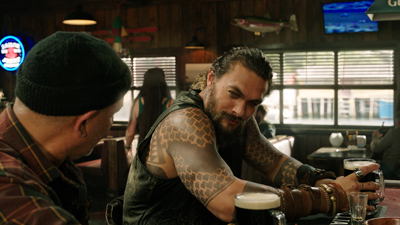 From the start, the director suggests, the two shared a unique understanding of Arthur's own dilemma. "Why I think Jason really connected with this character is his being of two worlds himself," says Wan, who also grew up divided between two different cultures. "Jason is a Hawaiian who grew up in middle America. He never quite felt like he fit into either world. And that's something I understand as well, as an Asian guy born in Malaysia who grew up in Australia. Having such a strong Australian upbringing, I've retained my Chinese/Malaysian heritage as well."
From the start, the director suggests, the two shared a unique understanding of Arthur's own dilemma. "Why I think Jason really connected with this character is his being of two worlds himself," says Wan, who also grew up divided between two different cultures. "Jason is a Hawaiian who grew up in middle America. He never quite felt like he fit into either world. And that's something I understand as well, as an Asian guy born in Malaysia who grew up in Australia. Having such a strong Australian upbringing, I've retained my Chinese/Malaysian heritage as well."
If the character of Arthur Curry was decreed to rule the undersea kingdom of Atlantis, Momoa may have been equally destined to play the role. In addition to his divided origins, elements of his islander life helped Momoa connect to the character more deeply as well. "Like Arthur, I was a half-breed, split between Iowa and Hawaii, so I could definitely identify with that. And from the Philippines to Hawaii to Tahiti and Fiji… Many islands have their celebrated water gods. That resonated with me instantly," he recalls.
That's not all. "I studied marine biology growing up in Iowa," Momoa adds, drawing further comparisons between himself and the character he plays. "Surprisingly, they had this campus in the middle of Des Moines, and it was all aquatics"sharks, eels and so on. I really love the ocean, being an islander. It's something that absolutely scares me, yet draws me in. It's calming. It's always evolving. It's always moving. Like fire, you can just stare at it. The mind's constantly entertained by it. You can get lost in it."
Momoa, who regularly surfed the South Pacific waves outside his seaside rental home in Australia's Gold Coast during the film shoot, adds that "in Polynesia, the shark is the protector for our family. They call it the mana, the supernatural power. I had this dream that I'm surfing and see a big shark. I'm like 'Hey, bro! I'm one of you!' I wish I really could talk to fish, to sharks. Of course, now that I'm Aquaman..." he muses.
Starring opposite Momoa, Amber Heard offers, "The filmmakers allowed who Jason is to inform our version of Aquaman, and Jason has really recreated the character. I think it is a very refreshing, modern, cool, totally different version of Aquaman that goes beyond what we would expect from the comics, but feels true to them at the same time."
Expanding on the duality of Arthur's nature, Momoa continues, "He's got a lot of bravado, but he does have compassion and even fears. He's a good man, but what makes him truly great is that only he can unite these two different societies because he is also Atlantean, and the chosen one. Yet what makes him human, even humble under all that swagger, is that he knows he is just not ready for it."
Unfortunately for Arthur, time is not on his side. His half-brother, Orm, has seen to that, and his plan to incite a war allowed the filmmakers to include vital messaging about the health of our planet in the story.
"Orm has decided to unite all the ocean kingdoms, and attack the surface world, largely because of all the things we do to pollute our oceans," Momoa explains. "Arthur doesn't care if he's king, he just doesn't want Orm to hurt the surface. Orm is all about uniting the seven kingdoms and taking over the whole world. So, Arthur finally sees that he has to stop him and the only way to do that is embark on this huge crusade, this epic road trip. That's the cool part because it has this 'Romancing the Stone' kind of vibe, which I really loved."
Leading the charge on said quest is Mera, the daughter of King Nereus and Princess of the undersea kingdom of Xebel. In addition to her royal status"which includes her dutiful engagement to Orm"she has the gift of hydrokinesis, an extraordinarily powerful ability to manipulate water.
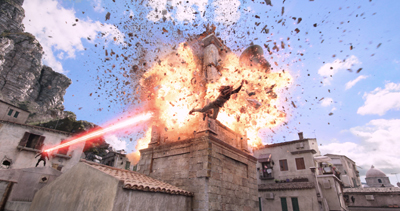 "What I love so much about our movie is that James, the writers, the producers…none of them wanted to create another damsel in distress in Mera," Heard says about her fiery heroine. "And I, for one, felt really thankful that they took that approach to a female protagonist. In her own right, Mera is very much an individual and is a proactive, driving force. I think audiences desire to see women occupy strong roles and she is, in every way, Aquaman's equal and time and again saves him as much as he saves her."
"What I love so much about our movie is that James, the writers, the producers…none of them wanted to create another damsel in distress in Mera," Heard says about her fiery heroine. "And I, for one, felt really thankful that they took that approach to a female protagonist. In her own right, Mera is very much an individual and is a proactive, driving force. I think audiences desire to see women occupy strong roles and she is, in every way, Aquaman's equal and time and again saves him as much as he saves her."
Mera indeed proves to be a formidable heroine and becomes Arthur's partner in an attempt to save the world. "She emerges from the water in the middle of the night, as a last resort, to drag a very reluctant, grudging Arthur out of the surface world, out of his sloppy, drunken, wistful, ignorant comfort zone by the lapels in order to get him to join her in the mission to stop King Orm from taking over," Heard continues. "She is the only one who can really persuade Arthur to go to Atlantis and save the world."
"In the comic book world, Mera is actually more powerful than Arthur is, in a lot of ways," notes Wan. "She has powers that even Arthur doesn't have, which I think is fascinating. I know that's what really attracted Amber to the part. But Amber also plays her with vulnerability, which I think this role calls for. In the movie, Mera is also trying to discover her place in her world. Both our lead characters go on this crazy, rite of passage journey, and they both learn who they are and what they're meant to be.
"When I first met Amber, the thing that struck me was how charismatic and charming she was. Young girls can look up to Mera, who is also such a smart, strong character."
"Amber is amazing," says Momoa. "There was a great connection, we got on like a houseon-fire. It's pretty much her and me just going everywhere on this quest, and it was super fun. And our characters are both badass. With her ability with water, Mera could kill Arthur, really. She's got this amazing power."
The source of Arthur's superpowers as Aquaman is his mother, Atlanna, who also served as an inspiration to a young Mera. Wan launches the entire adventure with an introduction to a New England lighthouse keeper named Tom Curry as he saves the life of a humanoid sea creature. She had washed up on the rocky shoreline adjacent to his watchtower during a fierce hurricane and, while nursing her back to health, he discovers that she is Atlanna, Queen of Atlantis, who fled her underwater kingdom after being betrothed to its hateful king. They fall in love and she bears a son, Arthur, named for the legendary king of Camelot.
Nicole Kidman stars as the Atlantean royal whose fight for freedom sets off the whole origin story. "She's a queen, but she's also a mother who has to sacrifice being with her son to save him," Kidman offers. "That's a big theme here, that sacrifice, what that costs a person and what that does to the family. I love the character because of her strength. James always said to me that Atlanna is the heartbeat of the story, which I thought was lovely."
"When we started the casting process for the role of Atlanna, we knew we needed an iconic actress to play this part," Safran states. "We knew it had to be somebody who would bring so much to the table, really bring gravitas to the role. We had heard that Nicole Kidman wanted to work with James, so when we reached out to her, it turned out that she did and that she wanted to find an interesting superhero movie as well because she'd never done one."
The genre held a lot of appeal for the actress, who says, "I'd just done two very dramatic films, so to then step into this world was really a fun opportunity. James showed me some of the storyboards and said, 'This will prove to you that I was always thinking of you,' because he had drawn me. How do you say no to that? And I love him, I love his energy, his enthusiasm, what he's putting out into the world. He's an auteur and applies himself with such passion and so much knowledge. And he's so good-natured, so it was an easy choice for me. Plus, he told me we would be shooting in Australia, which of course, for me, was like, 'yes please!'"
"We could not imagine anybody playing Atlanna other than Nicole," echoes Cowan. "There are those times during casting when you're not sure about availabilities. You have to think beyond your choices and ask yourselves, 'What if it doesn't work out? We'll have to look somewhere else.' We never came up with anybody else for Atlanna, and thankfully we didn't have to."
When Arthur is just a toddler, Atlanna reluctantly returns to Atlantis due to insurmountable circumstances. Once back, she will marry Orvax as planned, and give birth to a second son...
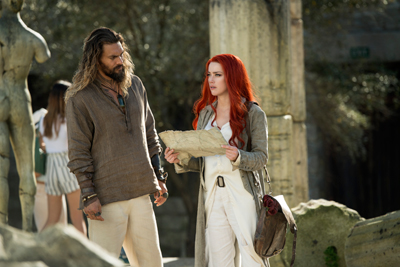 Super-Villains
Super-Villains
It is on land where Mera finds Arthur and tells him that his younger half-brother, Orm, the pure Atlantean son of Queen Atlanna and King Orvax, has commandeered the throne and intends to enlist the seven undersea kingdoms to conquer the surface world as retribution for mankind's pollution of the planet.
Orm's underlying goal is to rule over all of the undersea kingdoms and thereby declare himself Ocean Master. He detests his "half-breed" brother, and is determined to keep him away from his rightful place on the throne. Wan turned to frequent collaborator Patrick Wilson to play the maniacal monarch.
"Patrick Wilson is truly one of the best actors I've been fortunate to work with," Wan praises. "To me, he is like an amazing character actor trapped in the body of a leading man, and what I love about Patrick is just how much he disappears into his characters. Throughout the writing process, I just kept thinking that Patrick would be perfect for Orm, so I started writing him more for Patrick, hoping that when I got to the very end, I could convince the powers that be that he would be the right guy for this role. I just knew that Patrick would come into this and kill it."
"This is my fifth film with James, and it's the gift that just keeps on giving," Wilson says, reciprocating the compliment. "When he was first thinking about doing this movie, James said in passing to me, 'I want you to do Ocean Master.' And I took that with great reverence and responsibility…but I'm not going to lie and say I went out the next day and got a bunch of comics to brush up on because you never know. But that's James"he sticks to his word, and his dedication to his vision, and our friendship and working relationship."
Wilson also found the story very appealing. "What I loved when I read the script is that it took our inherent fascination with the ocean and explored what might happen if it turned on us. And while it's easy to label Orm a Super-Villain because throughout the comics' history he's been considered one, he has changed over the course of history in the comics. What James wanted to do, and what I think this movie does, is substantiate Orm's fight. He says it very clearly: 'For centuries, the surface world has been polluting the oceans and ruining my world.' So, there's a method to his madness. It's a very ecological fight he wants, and he believes the only way to defeat the surface world is to have all the other ocean kingdoms aligned with him. And if that happens, he becomes Ocean Master."
"I always love when a villain"who is always the hero of his own story"doesn't think he's evil," says Johnson-McGoldrick, examining the character of Orm. "He doesn't think he's out to aggrandize himself; he feels like he is justified in what he does. To Orm, his motivations are just, but he has an extreme approach. He's sick of the way humans are treating the oceans, so why not eradicate them?"
Safran allows that "Orm is not a typical bad guy, in the sense that a lot of his rationales for attacking the surface world are legitimate; he believes it's the only thing he can do to save and preserve his people. Because Arthur is technically the eldest born son of Atlanna, Orm knows that if Arthur appears in Atlantis there is certainly a claim he could make to the throne. He worries about being displaced as king, and his war against the surface falling apart."
"What also makes this story very interesting is that, in spite of Orm's concerns, Arthur doesn't want the throne," Wilson elaborates. "But Orm can't chance that he'll change his mind, so he has to stop Arthur, any way he can."
"I absolutely love him," Momoa states about Wilson. "I had a lot of great acting scenes with him. That was the best part. The stunt stuff comes kind of easy, it's fun being a kid and playing at fighting. But, when you get to act toe-to-toe with Patrick, his true strength is that he's a phenomenal actor."
As a man, Arthur makes it his mission to help those in danger. In an action-packed introductory sequence, he intervenes in a hijacking onboard a Russian submarine being held hostage by a band of pirates who have taken command of the vessel. A battle unfolds in which Arthur is able to spare the life of one young man, David Kane, while failing to save his father, who perishes inside the sub's torpedo chamber. It's a defining moment for Kane, who will seek vengeance for his father's death, sealing his own fate as Arthur's arch-enemy as he transforms himself into the fearsome Black Manta. Armed with a sword, a wrist-mounted harpoon gun and powerful optic sensors derived from Atlantean plasma, Black Manta's arsenal"along with his thirst for blood"could prove fatal for Aquaman.
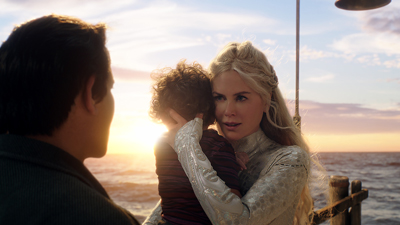 "I've always wanted to do an action movie, to be a big kid on the ultimate playground, and this is it," exclaims actor Yahya Abdul-Mateen II, who plays the role of Black Manta. "I love this one because it has something for everybody: if you love mythology, a really good love story, science fiction, combat scenes, or if you're a tech geek and just want to see how they're going to pull off the underwater world, then there's something for you here. And, at its core, I think there's a really strong story about a guy who has the keys to the kingdom, and doesn't want to be king. That's just epic!"
"I've always wanted to do an action movie, to be a big kid on the ultimate playground, and this is it," exclaims actor Yahya Abdul-Mateen II, who plays the role of Black Manta. "I love this one because it has something for everybody: if you love mythology, a really good love story, science fiction, combat scenes, or if you're a tech geek and just want to see how they're going to pull off the underwater world, then there's something for you here. And, at its core, I think there's a really strong story about a guy who has the keys to the kingdom, and doesn't want to be king. That's just epic!"
Abdul-Mateen II found the timing of the role to be significant. "I was in production as Black Manta in September of 2017, when the character turned 50 years old in the comics, so that was pretty cool to learn," the actor reflects. "As he's hitting the half-century mark, I'm portraying the character on film for the first time. That was just great."
"Black Manta is one of the true fan-favorites from the comic books and we knew we had to cast somebody who could live up to the expectations that exist for the role," says Safran. "And Yahya was that guy. For my money, superhero movies are only as good as the super villains the heroes are battling against. We wanted to make sure we delivered on that front."
"He's a mercenary who's known for his temper and for being ruthless, and throughout the canon he has a grudge against Aquaman," Abdul-Mateen II describes. "There are several different stories, but the story we're telling is his wanting revenge for his father's death. He's had a parent taken away, so he's alone, and he's angry, and that also makes him human. For him, his life starts over right there at the moment he loses his dad, and he's all about fulfilling a purpose, which makes him dangerous and unpredictable. I think he's a character who will have people on the edge of their seats."
A vicious character fans will know from the more recent canon is Captain Murk, a member of the elite Atlantean Commandos, King Orm's guard. Murk is loyal to Orm and to his vision of Atlantis as the ruling kingdom of the seas.
Ludi Lin, who was cast in the role, recalls, "I was in Beijing when I first talked with James, who described his vision for the film to me," says the China-born actor, who splits his time between China's entertainment capital wherever filming is taking place in the West. "I thought that made perfect sense because the earth is mostly water, and the ocean can be a savage place. There are different physics involved underwater, different rules apply and different creatures. It leaves so much to the imagination, and it's different from any other superhero movie."
In the comics, Murk is already striking in appearance, but the filmmakers and Lin took him to extremes. "He has a very distinct look to him, very different from how I usually look," Lin laughs. In the books, Murk is like a 40- or 50-year-old white dude with blonde hair, and James thought his look should have more scars, more veins, bleached hair, and eerily colored eyes, which makes him even more mysterious."
Father Figures
A lighthouse keeper, Thomas Curry is the love of Queen Atlanna's life, and human father to their son, Arthur. After Atlanna must leave them to return to Atlantis, Tom raises their boy to have compassion for his fellow man, but also to embrace the ocean and all its wonders. The filmmakers cast New Zealander Temuera Morrison in the role.
Cowan states, "Temuera Morrison was an automatic. As with Nicole, there was never anybody we had in mind beyond Temuera to play that role."
"The father-son relationship was cool because I had a good connection with Jason," Morrison smiles, reflecting on the natural spirituality he observed in Momoa during the shoot. "We witnessed some of the energy that was around Jason on this whole journey. He had visits on set from a couple Māori groups to wish him all the very best on his birthday, and they put on a big haka celebration. I, too, love the haka, the New Zealand fire dance, and Jason kind of got into that energy force on set as well. It seemed only fitting that Aquaman, the actor and the movie, be sealed with a bit of the dance of fire."
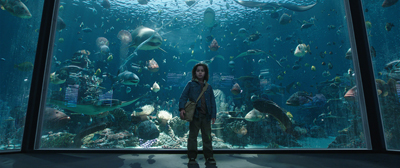 Morrison also enjoyed his scenes with Kidman, stating, "Nicole has a wonderful nature, very open, very gentle. James also wanted quite a bit of emotion, especially when she leaves me and my boy at a certain stage of the story, and I was glad that Nicole and I had nice chemistry."
Morrison also enjoyed his scenes with Kidman, stating, "Nicole has a wonderful nature, very open, very gentle. James also wanted quite a bit of emotion, especially when she leaves me and my boy at a certain stage of the story, and I was glad that Nicole and I had nice chemistry."
"Temuera was lovely to work with," Kidman states. "He's a New Zealander and I'm Australian, so there's a kind of language there, and a warmth, and that was fun."
Far from Arthur's unassuming dad is Mera's father, Nereus, King of Xebel, one of the other tribes of Atlantis. Dolph Lundgren plays the regal figure who concurs with Orm's belief that the violence of the surface dwellers will lead to their own end. He is not, however, convinced that Orm is the ruler who can unite the undersea kingdoms against them, having heard rumors of a true heir.
"The movie portrays a political game, this power struggle," Lundgren relates. "One of them, King Orm, is quite a powerful guy. King Nereus would prefer to keep the peace as much as possible. Even though the surface dwellers are people who do things he doesn't like, he sees Orm's wanting him to join his alliance against them as a sort of a shorthand for Orm taking over and becoming the Ocean Master.
"Nereus tries to argue the other side of the coin, which is not to go into war immediately," he continues. "He also has to consider that his daughter, Mera, was betrothed to King Orm when she was very young, so it's almost like a medieval setup, where families would marry into each other in order to keep the peace, but now… Orm is altering the terms of that arrangement."
Though the larger concerns of their families would eventually bring them together, Arthur's upbringing couldn't have been more different from Mera's, a young princess learning the ways of the underwater world. It's during his upbringing in the New England town of Amnesty Bay that Arthur, on a school field trip to a local aquarium, receives his first glimpse of his unique gift in communicating with sea life.
As the narrative unfolds in the film, Arthur thinks back on specific moments in his childhood when, while hoping to reunite with his mother, but unaware of her true fate, he was trained by Nuidis Vulko. Throughout Arthur's youth, Vulko was his one tie to his Atlantean side, having shown the lad the extraordinary abilities that come with his heritage, training him to breathe underwater, swim, and fight.
Council to the throne since the reign of Arthur's grandfather, and now advisor to King Orm, Vulko tries to encourage diplomacy between Atlantis and the other underwater kingdoms. At the same time, Vulko knows that Orm won't see reason, and that the only thing that can dethrone the megalomaniacal ruler is King Atlan's missing trident. He secretly directs Mera to find Arthur, and sends them off on their quest for the Trident of Atlan, before Orm can carry out his plans.
Wan cast venerable actor Willem Dafoe as the man who is at once mentor, diplomat and deceiver. "To have someone so respected as Willem in my film was fantastic," Wan declares. "He just gives it so much depth, so much believability. And on top of that, he is such a cool guy and really wanted to give it his all, and to do crazy action scenes! That's why he signed up to do this movie in the first place, to be a sort of Obi Wan or an old school Samurai to Arthur, so I wrote that into the role."
Dafoe relates, "Vulko is a teacher and a statesman and a bridge between the old and new Atlantean traditions. He's attached to the throne, now meaning King Orm, but he's conflicted, so there's a bit of court intrigue, so to speak. Like something out of Shakespeare, he's working both sides against the middle. And he also has this history of teaching Arthur how to fight and how to use a trident, building discipline in him. Arthur has a little too much 'surface' in him, so Vulko is stern with him sometimes, but also very kind."
The actor also appreciated the story's earth-friendly messaging. "It's not overly explicit or played too much," Dafoe observes, "but there was some good contemporary debate about how the underwater world comes into conflict with the surface because of how they've messed up the oceans."
Safran adds, "We were so fortunate to have Willem in our movie, it's such an important role and Willem brought a gravitas to it in such a beautiful manner."
Rounding out the cast are: Randall Park as Dr. Stephen Shin, a lone voice among earthlings in his belief in metahumans"specifically Aquaman"and the cause for the rising tide; Graham McTavish as King Atlan, keeper of the cryptic means to obtain the lost Trident; Michael Beach as David Kane's father, Jesse; John Rhys-Davies and Djimon Hounsou as the voices of the Brine King and King Ricou (aka the Fisherman King), respectively; and the legendary Julie Andrews as the voice of Karathen.
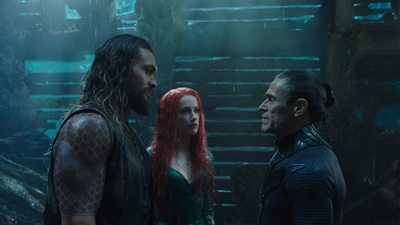 Looking The Part
Looking The Part
For veteran costume designer Kym Barrett, designing the heroic looks for "Aquaman" called for interpreting James Wan's vision and the imagery of such veteran DC comic book artist/illustrators as Paul Norris (Aquaman), Nick Cardy (Mera, Orm, Black Manta) and Ramona Fradon (Atlanna), in order to create costumes that would excite fans.
"The comic book flavor was something James was very passionate about keeping," says Barrett, who also had to consider the story's underwater environment, as it would inform most of the materials she would use in the approximately 2,500 pieces she would devise. "When trying to find our language for the movie, [production designer] Bill Brzeski and I talked at length about the rules of Atlantis. Everybody's floating or swimming or fighting under the water, with our cast on wires and rigs to look like they're floating. Of course, visual effects would help us at the end of the day with certain things, but we still had to keep all of this in mind when designing, in particular, to think about suspension and how to make clothes that appeared weightless. So, this gigantic job had even more layers for us to investigate and problem-solve."
Barrett and her team found themselves pondering the very "history" of Atlantis. "Atlanteans started off as surface people, then went under the ocean thousands of years ago. They somehow evolved, evolutionarily, so, for instance, did they grow web-like flippers for feet? We felt some would have, yes.
"In my mind," she continues, "their textures and shapes and colors"and especially their armor"were all influenced by the coral, the fish and the seaweed surrounding them. It is never practical for us to use real metals for armor because it would be heavy for the action and actors, who were always suspended. Instead, we created fabrics that looked metallic but weren't.
Beginning with the title character, "Arthur transitions from the surface world into the Atlantean world, and you'll see that progression in his costume," Barrett relates. "He's the reluctant hero, caught between land and sea, and he has to go through adversity and self-doubt to become the deserved king; a classic Everyman journey in which he's not just won the battle, he's become a more compassionate person. I like to think that our costumes helped take him from a dark, brooding guy to someone who's going to embrace being a unifier between Atlanteans and humankind.
"By the end of the film he's wearing an armor piece that came from the kingdom of Atlantis," she continues. "He has to feel like a king, and the design had to exude his heroic nature. Our job was to ensure it combined enough Jason and enough Aquaman the comic book hero, so that we believe Arthur's not just putting on a costume, he's putting on his new persona. For that moment, we tried to keep close to the comics' palette, while creating a modern, moodier version."
For Momoa, the hero suit was pure gold. "The first time I put it on, I wanted my kids to see it, so I took a picture and sent it to them," he remembers. "I got the big wide-eyed, mouth agape reaction, it just made them happy. It was cool to be a dad dressed up like that. And I fanboyed out a little myself. It was awesome."
As spectacular as the result was, the design was complicated, so Barrett collaborated with Jose Fernandez of Ironhead Studio and Justin Raleigh's Fractured FX design studio to bring Aquaman's iconic image to life. "It was a super complicated suit," she recalls. "We were involved a little bit with the initial designs, but it just made sense for Kym, Jose and I to come together to make this suit happen in a timely manner," Raleigh comments. "So, our team at Fractured FX ended up doing the whole gold top, his upper armor; Ironhead did gauntlets, boots and belt parts; and the rest of it was from Kym, who spearheaded the whole build with her team in Australia."
Raleigh's crew started by creating a new body scan for Momoa, who had reshaped his body to be bigger in the shoulders and latissimus muscles, and trimmer in the waist. "James had a very particular vision of what he wanted the suit to be," Raleigh continues, noting that the whole gold top was designed via computer and 3D printed in order to get the perfect symmetry. The suit was made of five distinct sections but rendered to appear completely seamless. "The chest drops in over the waist wrap and arms and covers the seams at the top of the arm and the seam at the pectoral area," he adds. "Then, a spine piece that drops down and covers the joints in the back, the zipper, and all the closures. In the end, it turned out to be this beautiful, pristine piece. Jason seemed really happy with the movement and the action that he got out of it, and for extreme actions, visual effects did some augmentation as well."
Also "worn" on and off throughout the film"including the first time we see him"are Arthur's tribal tattoos, inspired by Momoa's own. They had to be applied by the makeup department more than 100 times during the shoot.
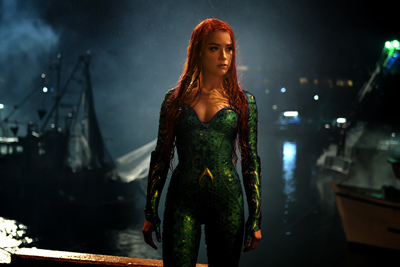 For the Atlanteans, Barrett and her team developed a theme. "With all the costumes, from Mera and Orm to all of the underwater kingdoms, we chose to use a kind of cellular building block structure in the pattern of everything," Barrett describes. "The 'scales,' as I called them, were actually hexagonal tiles that we handmade and hand painted, and then inserted into the printing of the fabric. That was one of the ways we were able to create that effect practically.
For the Atlanteans, Barrett and her team developed a theme. "With all the costumes, from Mera and Orm to all of the underwater kingdoms, we chose to use a kind of cellular building block structure in the pattern of everything," Barrett describes. "The 'scales,' as I called them, were actually hexagonal tiles that we handmade and hand painted, and then inserted into the printing of the fabric. That was one of the ways we were able to create that effect practically.
"For Amber's Mera costume, we adjusted the color slightly to flatter her natural complexion and eyes," Barrett says of Heard's sleek outfit. "It definitely had a kind of kick-ass feeling. You can believe she is a warrior, but she's not burdened with battle armor. The armor we imagined for her was something that Atlanteans would have organically grown as part of the clothing in their world. We focused on cooler greens, and I also made sure she looked good next to Aquaman. I think that first moment of Mera coming out of the water outside the tavern looked really great. It was a rainy night, the light was right and Amber emerged and you got the feeling she was someone quite otherworldly."
"Kym Barrett is a brilliant, hard-working, imaginative person who did an excellent job creating the trappings for this world Atlanteans live in," compliments Heard. "She incorporated only things that are found in the sea, which served as a foundation for all of our costumes. She did an amazing job."
Heard does confess to having something of a love/hate relationship with Mera's suit. "It was far more complex than it looks, and Kym and her team skillfully made it look both organic and extraordinary. But, in reality, because I always worked in harnesses and corsets, in various contraptions and mechanisms, everything was being squeezed and pulled, and I went home sore at the end of the day with mysterious bruises all over me. I had a weird relationship with that costume!"
For Patrick Wilson's Orm, Barrett designed two distinctive looks: a gold gladiatorial suit for his confrontation with his half-brother Arthur, and his regal silver armor and mask, worn once he anoints himself as the king of the seven kingdoms. "James wanted Orm's costume to be a very truthful reflection of the comic book, which is quite over the top, so I think we successfully blended the energy of the comic book with the reality of an actual person," Barrett states. "My inspiration for Patrick's look was to be reflective of the surrounding light, along with the ocean and aquatic life, so we built in an iridescence to evoke fish scales. In the end, I found it mercurial and ethereal."
Laughing, Wilson says, "There were times I wish I just wore the VFX gray pajamas, because this was a serious costume! Still, I don't think mine was nearly as heavy as Jason's. It was completely movable and so light, and worlds easier to fight in and move around."
What really transformed his performance, Wilson says, was Orm's head gear. "When I put on the sort of crazy, baroque mask of Ocean Master's, I just felt much different from when I was just in Orm's helmet. It was vital to the character."
A mask was also crucial to the character of Black Manta, and Barrett relates that many on her crew were excited to work on the design and build of the character's unique suit. "David Kane goes from a very ruthless, high-tech pirate to become the Black Manta. He builds his own suit like the one in the comic. We kept pretty true to it, with James very involved in that design. We again had a wonderful team at Ironhead Studio who helped us pull it all together."
Barrett says the group effort was key to combining Wan's design needs and the practical nature of building the suit for an actor to wear. "We had to make sure Yahya was allowed enough movement to act," she notes. "The base suit was constructed with water-compatible materials, which would also allow for performance, both dry and wet, and be stunt-compatible. Jose and his team sculpted all the hard elements, including the helmet, which needed to closely echo the comic book illustration and the maquette devised by Justin's team. The sculpts were then molded, cast, finished, assembled, painted and integrated into the base suit."
Visual effects supervisor Kelvin McIlwain notes, "The actual hero helmet was a bit heavy and unwieldy for our stunt guys to work in, so we manufactured a lightweight foam version that still gave you the representation of the scale and the size of it, while allowing Yahya's double to perform the stunts without undue risk."
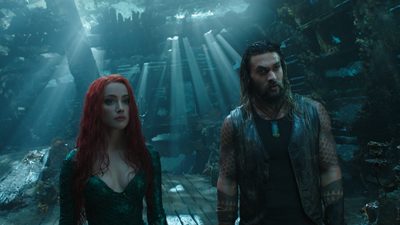 "One thing I was really excited about is that Manta's helmet shoots these laser-like energy beams, these plasma bolts," Abdul-Mateen says about donning the villain's black armor. "They shoot out of the helmet, but it has to recharge. It's not just an endless energy source, which makes it much more challenging for him."
"One thing I was really excited about is that Manta's helmet shoots these laser-like energy beams, these plasma bolts," Abdul-Mateen says about donning the villain's black armor. "They shoot out of the helmet, but it has to recharge. It's not just an endless energy source, which makes it much more challenging for him."
Barrett's design for Vulko not only took into account the comics canon, but Dafoe's personal taste as well. "I liked my costume," the actor says, "and I really liked my wig, too. It had a slight samurai feel to it, and I grew up on samurai movies so I really liked that little flavor to it. That was something James and I had discussed, so I know he and Kym did that for me." For Kidman's character, Atlanna, Barrett notes, "It's an extension of what we did with Mera and all the other characters, but I wanted her to have a Birth of Venus kind of reveal. So, she's in a mother-of-pearl iridescent bodysuit that allows for light to be able to bounce off it. She looked really special."
Light was also a critical element of the Atlantean soldiers' uniforms"literally. Picking up on the conceit of how the filmmakers turned to the idea of bioluminescence for lighting the depths of the ocean, Raleigh's company incorporated LEDs around the commandos' face plates, with small, light-colored filters inside, so they would reflect the blue light onto the actors' faces. The back piece contained a programmed disk, which utilized some 200 different lights on a control program.
"Everything was radio-controlled, even their weapons," Raleigh states. "Once all the guys were on-set, you just clicked one button and every suit turned on, sometimes up to 14 suits working at a time. And you could turn off one guy at a time as they died. Also, the red commandos contained a lobster design, with blues and little yellow and brown patterns to give it a bit of an organic element."
"Kym was a phenomenal addition to the team," says Safran. "She is such a creative person and she worked beautifully with James and with the outside studios to create the costumes for a whole new world. That's what was so interesting about this movie"we were creating from scratch things that people have never seen before. There were seven kingdoms to be dealt with, and she was a part of every aspect of building the Brine and Trench creatures, building the Atlanteans, building the surface world outfits… When people see the extraordinary nature of the wardrobe of this film, they will be blown away."
Of course, every battle required a type of weaponry, and the filmmakers turned to veteran property master Richie Dehne and his weapons coordinator Richard Mansfield to supply the various hand-held props that are part and parcel of a superhero lifestyle.
Drawing on the canon and what had been incorporated into the script, Wan's "Aquaman" combines the elements of such science fiction hallmarks as ray guns and other ultra-modern weaponry, while relying strongly on the Atlantean characters' iconic tridents for hand-to-hand combat.
In the early design stages, Dehne and Mansfield were relieved to find out that the film was being shot "dry for wet." Mansfield conveys, "I think it would've been a little too challenging otherwise, because we created weapons for our soldiers in which we put very high-tech electronics, so they could actually light up on set. They were connected to a lighting board, which is pretty unusual…it's the first time I've done it. Normally, you would have a weapon that would be self-contained that would light up itself. But, they were communicating via wireless technology to a lighting board operator, who had full control over it. That wouldn't have worked underwater."
In addition to the Atlantean soldier LED armaments, Dehne and Mansfield's biggest designs for the film were the assorted tridents for the story's various characters. Dehne notes, "The first trident we had was Atlanna's, which becomes Arthur's. We inherited it from the previous film, and that set the bar for us because it's a pretty extraordinary piece. It's actually a quindent, with five points, so a little poetic license was taken."
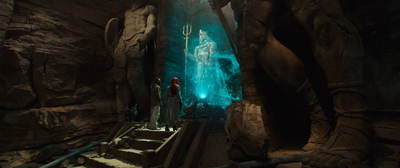 The team designed tridents for Orm, Nereus, King Ricou. "We took some liberties while trying to also be faithful to the original comics," Mansfield says.
The team designed tridents for Orm, Nereus, King Ricou. "We took some liberties while trying to also be faithful to the original comics," Mansfield says.
Their most significant design was for King Atlan's trident. "It is our Excalibur, our Holy Grail," Dehne offers. "Throughout the film, this is what Arthur and Mera are in search of, and it was fun to develop. One of the most important things that James was keen on was to have inscriptions on it. What would Atlantean text look like? So, off we went to the British Museum's collection of ancient texts, and pulled inspiration from there."
For the trident's color, Dehne wanted to ensure that its golden hue, refracted underwater, "would come out as the perfect gold for the cameras. We probably tried 20 different golds before we settled on the one we used. It might look simple, it might look like it's just a coat of paint, but it is a process that can sometimes take months to settle."
Getting In Fighting Shape
"After four and a half months of stunt training six days a week, you feel pretty superhuman," says Heard of the intense regimen she and her fellow cast members followed to be in superhero shape for "Aquaman."
Momoa, who arrived at the shoot in top condition, maintained his workout routine and spent a good deal of time on the climbing wall he had installed.
To look as though he could take on Momoa, Wilson took on a serious training schedule. "In the comic, Orm is a big dude," he explains, "and I've always been in shape, but I wanted to get bigger. It's Arthur's story and movie, his journey, but I tried to give him a formidable opponent in Orm. I changed my body type, probably gained about 15 pounds, sort of shifted the muscle around. I didn't just look like a skinny guy in a muscle suit."
"When Patrick was cast, knowing he'd be going up against Jason Momoa, he immediately said, 'I am going to start working out this instant,'" Safran recalls. "And he was religious about his regimen. He worked out every day of the week back east before he came down to Australia and when he showed up on location, he had transformed himself into a guy that, when he stood next to Jason on set, you weren't sure who would win that fight!"
Abdul-Mateen II looked forward to his scenes with Momoa as well. "I just followed Jason's lead on the fight stuff, because I'm pretty new to this," he says. "Jason's a pro, an expert at handto-hand combat acting. So, I just came in and brought a whole lot of energy to those moments. Jason is very similar to myself in that we're both just big kids."
Though his character is meant to be more statesman then brawler, Dafoe enjoyed performing the variety of stunts required by the story. "It's not normal movement," he says. "You're flying around quite high, diving and doing barrel rolls and things like that, and figuring out how to do that elegantly was complicated, but a lot of fun. At several points I was riding a big blue cube nicknamed Muriel, which became a hammerhead shark in effects later!"
The swimming had to feel organic, it had to look like they were really passing through water in a way that felt natural. The filmmakers did extensive research and discovered certain techniques developed in the last few years to affect this. They then took those techniques and built on them, creating new equipment"such as rigs"that did the job even more effectively. Because different environments required different motion, the rigs required to move the actors about had to be specialized. Through trial and error, Cox's team, along with input from stunt coordinators R.A. Rondell and Kyle Gardiner, devised a plan.
"We figured out early on that if the cast didn't look right doing what they're doing 'underwater,' it wasn't going to work," Cox says. "We put a lot of time and effort into solving that, using teeter-totters and TV studio camera pedestals, and they worked out really well. The actors were suspended by tuning forks to let them have realistic, fluid movement."
"I was part of the 'Matrix' crew, so the tuning forks came from that originally," Rondell offers. "What we used here was a hybrid of that."
In describing the equipment, Gardiner says, "Tuning forks look just like a fork attached to a giant steel pole. We had a series of different heads to which the actors were suspended by their hips. These special harnesses allowed cast and stunts three to four different axes, depending which head we used. Also, the forks could be suspended from the ceiling, or smaller versions were suspended from a ground-based system that we drove around."
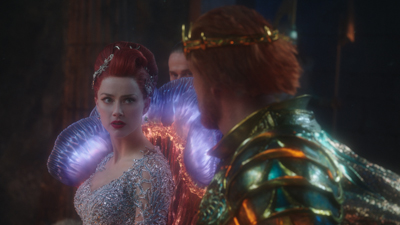 "The 'mambos,' as we called our rigs, were something that we brought to the table," says Rondell. "Every character in this film had to be moving in some fashion, and we tried all kinds of different ways to manipulate the movement of their bodies."
"The 'mambos,' as we called our rigs, were something that we brought to the table," says Rondell. "Every character in this film had to be moving in some fashion, and we tried all kinds of different ways to manipulate the movement of their bodies."
"Working from past experience, we devised different ways to simulate floating," Gardiner adds, "but we needed to come up with a method that was quick and easy to allow for dialogue and movement underwater while the cameras did their thing. Production had the idea of using a TV camera base to stabilize the tuning forks, and we kind of built off that with cantilevered, counterweight systems to create the sense of gentle flow. Gravity also applies to people underwater, and the cast had to stand, walk, float or swim to a position. In meeting those challenges, we took each actor and gave them time to develop their physicality"how they wanted to move when attached to our assorted rigs."
Due to the requirements of the wire suspension work and the tuning forks, the stunt team acted essentially as puppeteers, pulling strings, or wires in this case, and moving around on the stage floor while the actors moved on the rigs. Rondell describes it as "a dance between the actors and the stunt team, working together to react and move and not look like anything was false."
"We have many fight sequences in this movie," Wan notes. "Think about all the martial arts fight sequences we know from other movies that we've seen, then imagine what that would look like if it was underwater. On top of that, these are super beings who have this incredible ability to move beneath the ocean's surface. That's the kind of stuff that we had to think about with our stunt guys."
A New World
"Aquaman" filmed largely in Australia's Gold Coast, Queensland, on the continent's east coast south of Brisbane. The production utilized all nine of Village Roadshow Studios' soundstages, including its newest, Stage 9. Among the more than 50 sets created for the film, it housed such prominent sites as the Atlantis Throne Room and Coliseum, King Orm's warship and the magnificent Throne of the Dead King.
Even with the massive space, the greatest challenge in filming a primarily underwater world is…water. "Whenever possible, I'm a very practical person. I love shooting with practical effects, I like to be able to see them and touch them," says Wan. "As much as I can bring into the real world, the better it is, so we shot a lot of dry-for-wet on this one. There was a lot of blue screen work, but there were many days where we had physical set pieces, and we submerged them into a water tank. For me, there are things that you still need to shoot in the real world; it's only the super complicated effects that require digital work. Of course, there were quite a few of those as well. This was a challenging shoot that used both practical and digital effects."
Production designer Bill Brzeski says, "The challenge of creating a superhero movie is enormous anyway. Pair that with making it look like you're shooting underwater and dealing with the physics of an undersea world. We understood that we couldn't work underwater, and at least two-thirds of the story is set there, so it was complex."
Brzeski says, "Atlantis happened when a whole culture descended underwater and stayed there, evolving into seven different kingdoms: Atlantis, Brine, Fisherman, Xebel, Trench, Deserter and the Lost. And most of them don't even know what's on the surface because they don't go up there. So, it's like two different worlds occupying the same planet that don't contact each other ever. Or at least not until this movie."
In creating the physical sets of Atlantis, Brzeski designed "a neoclassic culture from somewhere in the Mediterranean…possibly forerunners to the Greeks, the Hellenistic period. Even pre-Egyptian. But what sets it apart is that it is also a culture that was on the verge of digital technology."
As he had with Barrett for the costumes, Wan talked at length with Brzeski "about building materials in the surface world such as brick, wood, metal, and the types of fabric we wear.
Materials they wouldn't necessarily have down there," the director says. "So, we tried to pull a lot of influences from the ocean, from the maritime, nautical world. The idea that maybe their buildings were very much organic, like coral. Is it a living thing that they live inside? Also, what gives them light in this world? They're down so deep that sunlight doesn't penetrate the ocean. What replaces sunlight? The cycle of the sun is what gives us our ticking body clock, our biorhythm, right? If you don't have the sun, what does that? What provides their light source?"
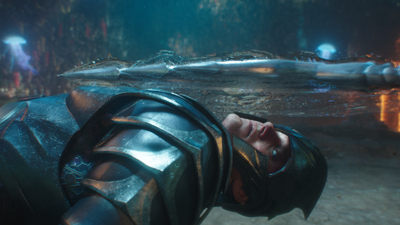 "That was a great challenge," Brzeski notes, "and we came up with the logic of bioluminescence and glowing coral. Creatures in the ocean depths make their own light through bioluminescence, so we maintained that Atlanteans weren't a primitive culture that went underwater; they were already pretty advanced."
"That was a great challenge," Brzeski notes, "and we came up with the logic of bioluminescence and glowing coral. Creatures in the ocean depths make their own light through bioluminescence, so we maintained that Atlanteans weren't a primitive culture that went underwater; they were already pretty advanced."
In order to capture the civilization on camera, Wan collaborated with director of photography Don Burgess, who came to the production with a few special lighting techniques when it came to water. "It's one of the oldest tricks in the book: water trays above the stage, situated beneath the rafter lights. You then focus these computer driven lights to send it into a pattern that makes you feel like you're underwater, with a ripple effect created by using ropes to shimmer the water in the trays," he reveals.
"I've shot a lot of films on the water and under the water," Burgess continues. "The challenge of this movie was creating this underwater world in a dry environment. So, we developed techniques, things that I've tried a little bit in the past, but never to this extent. This was pushing it to the extreme, and I love when we can challenge ourselves to do things we haven't done before."
Elaborating, Burgess says, "In this film, we used a lot of computer-driven lights and a lot of camera movement to create the feeling of being underwater. There's a certain way that light travels through water. We studied that before trying to emulate that in some of the sets that we built. We also used shutter speeds and camera angles and the length of exposure to manipulate the image, to allow audiences to feel like they are sitting in the depths of the sea."
While much of Atlantis was created via CGI in post-production, two of Brzeski's functional stage set pieces reflecting the underwater kingdom included the ring of fire dojo, which he dubs "our take on a gladiatorial coliseum," and the hall of armor where, he says, "the gladiators suit up. It's a room with columns adorned with gladiator outfits and huge power armor that's been around for thousands of years."
One of the designer's most impressive submerged set pieces consumed the studio's Stage 8: a sunken galleon completely encrusted with barnacles and seaweed. "That was a phenomenal set," praises Safran. "It's where Vulko lays out the quest for Mera and Arthur, and it's where a great action sequence takes place with Atlantean commandos attacking Arthur. We couldn't believe the look and feel of the set"every barnacle, every bit of coral looks like it's been there forever. Bill really hit it out of the park with that one."
In the story, the galleon has developed an airtight pocket inside its hull, so the crew built an old-fashioned waterfall device called a "laminar flow," a wall of water where Arthur and Mera swim from the ocean depths into a void inside the ship. The device proved to be somewhat tricky as the sheet of water would only remain for so long before terminal velocity would break it up.
Yet even with such challenges, the overall effect was right on target. The laminar flow was tripled in size and repeated for a later scene in which Arthur walks through a waterfall in full Aquaman regalia"the green and gold hero suit.
Brzeski admits that one of his favorite sets was the "Temple of the Dead King," a pyramidlike structure erected in a corner of Stage 9 on which the cadaver of the dead King Atlan sits on a throne, his cold, lifeless hands frozen tightly around the sacred trident. "This temple is a cavernous domed hall, a huge hollow spot beneath the Earth's crust," Brzeski says of the crucial set piece, which sat against 30-foot blue-screen curtains that would allow the CG technicians to create its gaping backdrop. "It's a magical place in the story, this 'journey to the center of the earth' ocean inside the Earth's core akin to the Carlsbad Caverns, but much, much bigger," the designer details.
A decidedly non-Atlantean set was the Russian submarine commandeered by high seas pirates, a portion of which"its torpedo room" was built above an indoor tank and submerged during a fight between Arthur and David Kane. The action was enabled via one of SFX supervisor Brian Cox's many mechanized gimbals, built for a variety of moving set pieces on the film. Additional sets ranged from Black Manta's ray-shaped sub and his workshop, to the inside of a whale's mouth where Arthur and Mera take refuge, to the homey interiors of Tom Curry's watchtower.
The Curry home is nestled in the fictional New England town of Amnesty Bay; plate shots of Newfoundland doubled for the quaint village. Brzeski and art director Bill Booth designed the set, a complete four-walled lighthouse overlooking the South Pacific in the village of Hastings Point, New South Wales. Brzeski states, "We looked for landscapes that would be reminiscent of Maine and, for the most part, Australia doesn't look like Maine. It's a different kind of rock. Different fauna and flora and all that. But Hasting's Point was a great find: a beautiful beachhead where the rocks come out of the water amid crashing waves, breaching whales in the distance. It was a great place to build our lighthouse and make it look like it was in New England."
Built in a warehouse dozens of miles away, the exterior lighthouse set was transported in pieces and assembled on the site like a giant jigsaw puzzle. "The place is a national park right on the ocean, and we didn't want to disturb the land or damage the landscape," explains Brzeski. Like every cozy neighborhood by the sea, Amnesty Bay has a favorite neighborhood watering hole: Tom and Arthur's is Terry's Sunken Galleon Bar, erected on a piece of land called The Spit, a permanent sand dune that separates the inter-coastal broad water from the South Pacific in the Main Beach neighborhood of Gold Coast, a half hour south of the film studios. It quickly became a production favorite.
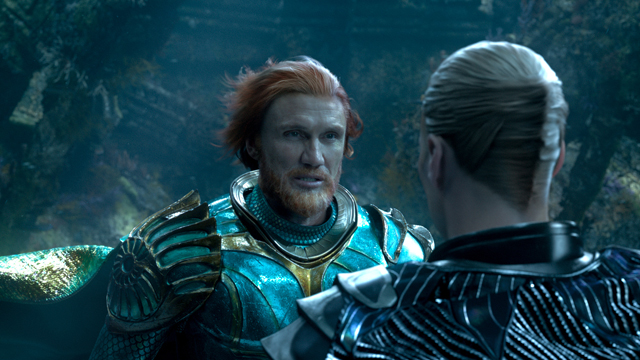 The cast and crew weren't the only ones who felt at home at Terry's. "We had locals pulling up outside once we got the signs up, commenting that they never knew this bar existed," says set decorator Bev Dunn. "What added to the ambiance of that practical set was the smell of the ocean right outside the windows. You would never get that on a soundstage."
The cast and crew weren't the only ones who felt at home at Terry's. "We had locals pulling up outside once we got the signs up, commenting that they never knew this bar existed," says set decorator Bev Dunn. "What added to the ambiance of that practical set was the smell of the ocean right outside the windows. You would never get that on a soundstage."
Another perfect spot for one of the film's dramatic sequences was found on an antiquated island paradise called North Stradbroke Island, just off the coast of Brisbane, Queensland's capital city. A secluded gorge on the island's north shore, called Lookout Point, served as the exterior portion of "Dead King Island."
In addition to its many ideal finds and its numerous stage builds, the production also utilized the studio's sprawling backlot, where Brzeski erected a handsome Italian piazza, based on an actual Sicilian hilltop village called Erice, for an intense chase sequence. Cameras also captured breathtaking exteriors in Italy and Morocco.
Finishing Touches
Throughout production, VFX supervisor McIlwain's team was in high gear. "I have a history with James, and with that comes trust as well," McIlwain says. "When we first met about this film, he had put together an amazing package of concepts and visual references mapping out the project. I was just blown away. We have seven undersea realms that we visit throughout the movie, some of which involve thousands of almost entirely CG creatures, like the Brine King and Trench. The only way we could effectively place our actors in most of our environments was to shoot them in a dry-for-wet situation, which posed a lot of challenges. It's not like you're in space, not like zero-g. There's still gravity and physics at play.
"One of the most obvious ones right off the top had to do with hair, because hair, clothing, everything behaves very differently underwater," he continues. "And because we shot the cast in a dry environment, everybody's hair had to be rendered in CG. We constantly played with different frame rates, different rigs to move the actors around and give them that sort of underwater movement feeling. The underwater environments that we created…I don't think we've ever seen anything like them before."
Add to that the sheer amount of footage to manage. "Other shows have done dry-for-wet in very short sequences and snippets," McIlwain points out. "We created an entire undersea world. You have Atlantis, the Fisherman Kingdom, the Kingdom of the Brine... And every realm has a different look to it. The challenge was just the enormity of it all. Literally everything had to be shot in a blue screen environment. It would have been a nightmare to shoot in real water. I don't know how you'd do it. You absolutely couldn't do it."
Because the technology they used is so new and, in effect, groundbreaking, "even ten years ago, I think it would have been extremely difficult to make a movie like this," McIlwain states unequivocally. "We relied on the latest technologies, like MoCap cameras and Virtual Production, which allowed us to look through the camera and frame up a shot. Your actor is there, maybe sitting on a motion base to replicate a sea creature that he's riding. We can then look through the camera and see the creature he's riding and the environment he's in."
Safran remarks, "The Virtual Production was a tremendous tool because it allowed us to deal with the scale and scope of the environments while enabling us to place our actors within that geography in the right manner. It allowed the actors to understand how they were interacting with what will ultimately be pure CGI creatures and individuals."
"It's a fairly new piece of technology, probably been around five years," pre-visualization supervisor Eric Carney details. "James seemed to really enjoy working with the technology. He used it constantly to adjust the actor's performance, or the camera set-ups, to get an idea of what to expect when visual effects are applied later on."
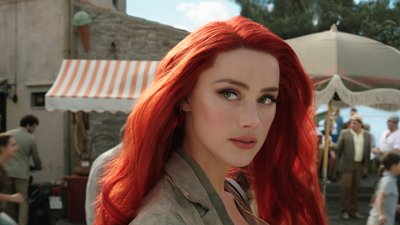 To bring the film's themes to life musically, Wan turned to composer Rupert GregsonWilliams, who says, "Writing the themes for the different characters was awesome. Arthur has such a strong character"he's a real rock star"so I felt he deserved a big orchestral melody. He gets to rock out for certain intense moments. Orm is Atlantean, and the score I wrote for Atlantis is in big contrast to the score for the surface world, epic and glorious. Black Manta inspired a more industrial, electronic feel. And, of course, there's romance"two in fact. Atlantis and the entire world James created is truly amazing, giving me such a rich opportunity."
To bring the film's themes to life musically, Wan turned to composer Rupert GregsonWilliams, who says, "Writing the themes for the different characters was awesome. Arthur has such a strong character"he's a real rock star"so I felt he deserved a big orchestral melody. He gets to rock out for certain intense moments. Orm is Atlantean, and the score I wrote for Atlantis is in big contrast to the score for the surface world, epic and glorious. Black Manta inspired a more industrial, electronic feel. And, of course, there's romance"two in fact. Atlantis and the entire world James created is truly amazing, giving me such a rich opportunity."
"The world that James has built is not only beautiful, but terrifying, and all…unknown," says Momoa of the director's vision for the uncharted universe found in "Aquaman." "There aren't too many movies I've been in where kids get to watch, so I'm excited to sit down with my own children and watch this one. That will be a trip! It was cool to be part of it. Yeah, all the dreams are coming true."
Having taken what amounts to an epic journey himself to realize his vision for the film, in summary, Wan says, "I feel this is a story that's very relevant, with elements of it reflected in the world we're living in now, which, to me, is important"telling stories that speak to the times. I think that, ultimately, every superhero story should be a lot of fun and take you on an amazing adventure, and at the same time make you feel you've learned something from these characters and that you, yourself, have the ability to do good. And you don't necessarily need a cape to be able to do that!"
Aquaman
Release Date: December 26th, 2018
MORE





